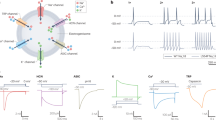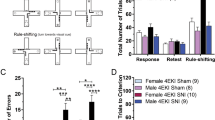Abstract
Increasing knowledge of the molecular consequences of nerve injury and the availability of genome databases has greatly increased the range of potential targets for the pharmacological management of neuropathic pain. Controlling neuronal sensitization and the associated alterations in gene expression, protein modification, and neuronal excitability is the key to managing neuropathic pain. Control of neuronal sensitization can occur through inhibition of nerve injury-associated production of cytokines, activation of glial cells, modulation of potassium channel subtypes, mitogenactivated protein kinases, the ubiquitin-proteasome system, or the protection and amplification of spinal cord dorsal horn inhibitory systems. These new and already established targets promise unparalleled opportunities for the prevention, management, and resolution of persistent pain states following nerve injury.
Similar content being viewed by others
References and Recommended Reading
Watkins LR, Maier SF: Beyond neurons: evidence that immune and glial cells contribute to pathological pain states. Physiol Rev 2002, 82:981–1011. This review makes a detailed case for the role of glial cells in the generation and maintenance of neuropathic pain. The discussion of non-nociceptive effects of glial cell and cytokine activation may help explain behavioral and cognitive symptoms in patients with nerve injury-associated pain.
DeLeo JA, Yerzierski R: The role of neuroinflammation and neuroimmune activation in persistent pain. Pain 2001, 90:1–6.
Okamoto K, Martin DP, Schmelzer JD, et al.: Pro- and antiinflammatory cytokine gene expression in rat sciatic nerve chronic constriction injury model of neuropathic pain. Exp Neurol 2001, 169:386–391.
Rutkowski MD, DeLeo JA: The role of cytokines in the initiation and maintenance of chronic pain. Drug News Perspect 2002, 15:626–632.
Nichol GD, Lopshire JC, Pafford CM: Tumor necrosis factor enhances the capsaicin sensitivity of rat sensory neurons. J Neurosci 1997, 17:975–982.
Cui JG, Holmin S, Mathiesen T, et al.: Possible role of inflammatory mediators in tactile hypersensitivity in rat models of mononeuropathy. Pain 2000, 88:239–248.
Lindenlaub T, Sommer C: Cytokines in sural nerve biopsies from inflammatory and non-inflammatory neuropathies. Acta Neuropathol 2003, 105:593–602.
Wagner R, Myers RR: Schwann cells produce tumor necrosis factor alpha: expression in injured and non-injured nerves. Neuroscience 1996, 73:625–629.
Sorkin LS, Doom CM: Epineurial application of TNF elicits an acute mechanical hyperalgesia in the awake rat. J Peripher Nerv Syst 2000, 5:96–100.
Sorkin LS, Xiao WH, Wagner R, Myers RR: Tumor necrosis factor alpha induces ectopic activity in nociceptive primary afferent fibers. Neuroscience 1997, 81:255–262.
Schafers M, Svensson CI, Sommer C, Sorkin LS: Tumor necrosis factor alpha induces mechanical allodynia after spinal nerve ligation by activation of p38 MAPK in primary sensory neurons. J Neurosci 2003, 23:2517–2521.
Shafers M, Lee DH, Brors D, et al.: Increased sensitivity of injured and adjacent uninjured rat primary sensory neurons to exogenous tumor necrosis factor-alpha after spinal nerve ligation. J Neuroscience 2003, 23:3028–3038.
Shafers M, Sorkin LS, Geis C, Shubayev VI: Spinal nerve ligation induces transient upregulation of tumor necrosis factor receptors 1 and 2 in injured and adjacent uninjured dorsal root ganglia in the rat. Neurosci Lett 2003, 347:179–182.
Shubayev VI, Myers RR: Anterograde TNF alpha transport from rat dorsal root ganglion to spinal cord and injured sciatic nerve. Neurosci Lett 2002, 320:99–101.
Shafers M, Sorkin LS, Sommer C: Intramuscular injection of tumor necrosis factor-alpha induces muscle hyperalgesia in rats. Pain 2003, 104:579–588.
Empl M, Renaud S, Erne B, et al.: TNF-alpha expression in painful and nonpainful neuropathies. Neurology 2001, 56:1371–1377.
Igarashi T, Kikuchi S, Shubayev V, Myers RR: Exogenous tumor necrosis factor-alpha mimics nucleus pulposus-induced neuropathology. Spine 2000, 25:2975–2980.
Karppinen J, Korhonen T, Malmivaara A, et al.: Tumor necrosis factor-alpha monoclonal antibody, infliximab, used to manage severe sciatica. Spine 2003, 28:750–754.
Diem R, Meyer R, Weishaupt JH, et al.: Reduction of potassium currents and phosphatidylinositol 3-kinase-dependent Akt phosphorylation by tumor necrosis factor-alpha rescues axotomized retinal ganglion cells from retrograde cell death in vivo. J Neurosci 2001 21:2058–2066.
Fine SM, Angel RA, Perry SW, et al.: Tumor necrosis factor alpha inhibits glutamate uptake by primary human astrocytes. J Biol Chem 1996, 271:15303–15306.
Beattie EC, Stellwagen D, Morishita W, et al.: Control of synaptic strength by glial TNF alpha. Science 2002, 295:2282–2285. This is an elegant study demonstrating a role for glial TNF-α in enhancing synaptic strength through the expression of synaptic AMPA receptors. These findings have implications for activitycontrolled synaptic strength and possible neurotoxicity from excessive neuron-glia interaction.
Esteban JA: AMPA receptor trafficking: a road map for synaptic plasticity. Mol Intervent 2003, 3:375–385.
Murphy PG, Borthwick LS, Johnston RS, et al.: Nature of the retrograde signal from injured nerves that induces interleukin-6 mRNA in neurons. J Neurosci 1999, 19:3791–3800.
Wagner R, Janjigian M, Myers RR: Anti-inflammatory interleukin-10 therapy in CCI neuropathy decreases thermal hyperalgesia, macrophage recruitment and endoneurial TNF alpha expression. Pain 1998, 74:35–42.
Sweitzer SM, Schubert P, DeLeo JA: Propentofylline, a glial modulating agent, exhibits antiallodynic properties in a rat model of neuropathic pain. J Pharmacol Exp Ther 2001, 297:1210–1217.
Yost CS: Potassium channels: basic aspects, functional roles, and medial significance. Anesthesiology 1999, 90:1186–203.
Chaplin SR, Guo HQ, Lee DH, et al.: Neuronal hyperpolarization-activated pacemaker channels drive neuropathic pain. J Neurosci 2003, 23:1169–1178.
BoSmith RE, Briggs I, Sturgess NC: Inhibitory actions of ZENECA ZD7288 on whole-cell hyperpolarization activated inward current (If) in guinea-pig dissociated sinoatrial node cells. Br J Pharmacol 1993, 110:343–349.
Rasband MN, Park EW, Vanderah TW, et al.: Distinct potassium channels on pain-sensing neurons. Proc Natl Acad Sci 2001, 98:13373–13378.
Wang H, Sun H, Della Penna K, et al.: Chronic neuropathic pain is accompanied by global changes in gene expression and shares pathobiology with neurodegenerative diseases. Neuroscience 2002, 114:529–546.
Johns DC, Marx R, Mains RE, et al.: Inducible genetic suppression of neuronal excitability. J Neurosci 1999, 19:1691–1697. This study represents a remarkable technical achievement and a glimpse into a possible gene therapy approach for analgesia.
Derjean D, Bertrand S, LeMasson G, et al.: Dynamic balance of metabotropic inputs causes dorsal horn neurons to switch functional states. Nat Neurosci 2003, 6:274–281.
Passmore GM, Selyanko AA, Mistry M, et al.: KCNQ/M currents in sensory neurons: significance for pain therapy. J Neurosci 2003, 23:7227–7236.
Jentsch TJ: Neuronal KCNQ potassium channels: physiology and role in disease. Nat Rev Neurosci 2000, 1:21–30.
Wickenden AD, Yu W, Zou A, et al.: Retigabine, a novel anticonvulsant, enhances activation of KCNQ2/Q3 potassium channels. Mol Pharmacol 2000, 58:591–600.
Blackburn-Munro G, Jensen BS: The anticonvulsant retigabine attenuates nociceptive behaviours in rat models of persistent and neuropathic pain. Eur J Pharmacol 2003, 460:109–116.
Ji RR, Woolf CJ: Neuronal plasticity and signal transduction in nociceptive neurons: implications for the initiation and maintenance of pathological pain. Neurobiol Dis 2001, 8:1–10. A review article covering the role of intracellular kinases in neuronal sensitization with applications to neuronal plasticity in persistent pain.
Grewal SS, York RD, Stork PJ: Extracellular signal-regulated kinase signaling in neurons. Curr Opin Neurobiol 1999, 9:544–553.
Ono K, Han J: The p38 signal transduction pathway activation and function. Cell Signal 2000, 12:1–13.
Gupta S, Barret T, Whitemarsh AJ, et al.: Selective interaction of JNK protein kinase isoforms with transcription factors. EMBO J 1996, 15:2760–2770.
Tsuda M, Mizokoshi A, Shigemoto-Mogami Y, et al.: Activation of p38 mitogen-activated protein kinase in spinal hyperactive microglia contributes to pain hypersensitivity following peripheral nerve injury. Glia 2004, 89:89–95.
Dai Y, Iwata, Fukuoka T, Kondo E: Phosphorylation of extracellular signal-regulated kinase in primary afferent neurons by noxious stimuli and its involvement in peripheral sensitization. J Neurosci 2002, 22:7737–7745.
Kenney AM, Kocsis JD: Peripheral axotomy induces long-term c-Jun amino-terminal kinase-1 activation and activator protein-1 binding activity by c-Jun and junD in adult rat dorsal root ganglia in vivo. J Neurosci 1998, 18:1318–1328.
McMahon SB, Kett-White R: Sprouting of peripherally regenerating primary afferent sensory neurons in the adult central nervous system. J Comp Neurol 1991, 304:307–315.
Woolf CJ, Shortland P, Reynolds M, et al.: Reorganization of central terminals of myelinated primary afferents in the rat dorsal horn following peripheral axotomy. J Comp Neurol 1995, 360:121–134.
Bennett BL, Sasaki DT, Murray BW, et al.: SP600125, an anthrapyrazolone inhibitor of c-Jun N-terminal kinase. Proc Natl Acad Sci 2001, 98:13681–13686.
Maroney AC, Glicksman MA, Basma AN, et al.: Motoneuron apoptosis is blocked by CEP-1347 (KT 7515), a novel inhibitor of the JNK signaling pathway. J Neurosci 1998, 18:104–111.
Saporito MS, Thomas BA, Scott RW: MPTP activates c-Jun NH2-terminal kinase (JNK) and its upstream regulatory kinase MKK4 in nigrostriatal neurons in vivo. J Neurochemistry 2000, 75:1200–1208.
Curran BP, Murray HJ, O’Connor JJ: A role for c-Jun N-terminal kinase in the inhibition of long-term potentiation by interleukin-1b and long-term depression in the rat dentate gyrus in vitro. Neuroscience 2003, 118:347–357.
Karin M, Chang L: AP-1-glucocorticoid receptor cross-talk taken to a higher level. J Endocrinol 2001, 169:447–451.
Herrlich P: Cross-talk between glucocorticoid receptor and AP-1. Oncogene 2001, 20:2465–2475.
Glickman MH, Ciechanover A: The ubiquitin-proteasome proteolytic pathway: destruction for the sake of construction. Physiol Rev 2002, 82:373–428.
Wilkinson KD: Ubiquitination and deubiquitination: targeting of proteins for degradation by the proteasome. Semin Cell Dev Biol 2000, 11:141–148.
Büttner C, Sadtler S, Leyendecker A, et al.: Ubiquitination precedes internalization and proteolytic cleavage of plasma membrane-bound glycine receptors. J Biol Chem 2001, 276:42978–42985.
Abriel H, Kamynina E, Horisberger JD, Staub O: Regulation of the cardiac voltage-gated Na+ channel (H1) by the ubiquitinprotein ligase Nedd4. FEBS Lett 2000, 466:377–380.
Burbea M, Dreier L, Dittman JS, et al.: Ubiquitin and AP18-regulate the abundance of GLR-1 glutamate receptors at postsynaptic elements in C elegans. Neuron 2002, 35:107–120.
Hegde AN, Goldberg AL, Schwartz JH: Regulatory subunits of the cAMP-dependent protein kinases are degraded after conjugation to ubiquitin: a molecular mechanism underlying long-term synaptic plasticity. Proc Natl Acad Sci U S A 1993, 90:7436–7440.
Hegde AN, DiAntonio A: Ubiquitin and the synapse. Nat Rev Neurosci 2002, 3:854–861. A clearly written review of ubiquitin’s role in shaping synaptic growth and remodelling.
Ehlers MD: Activity level controls postsynaptic composition and signaling via the ubiquitin-proteasome system. Nat Neurosci 2003, 6:231–242.
Moss A, Blackburn-Munro G, Garry EM, et al.: A role for the ubiquitin-proteasome system in neuropathic pain. J Neurosci 2002, 22:1363–1372.
Richardson PG, Barlogie B, Berenson J, et al.: A phase-2 study of bortezomib in relapsed, refractory myeloma. N Engl J Med 2003, 348:2609–2617.
Araki T, Milbrandt J: ZNRF proteins constitute a family of presynaptic E3 ubiquitin ligases. J Neurosci 2003, 23:9385–9394.
Wong BR, Parlati F, Qu K, et al.: Drug discovery in the ubiquitin regulatory pathway. Drug Discov Today 2003, 8:746–754.
Woolf CJ, Salter MW: Neuronal plasticity: increasing the gain in pain. Science 2000, 288:1765–1768.
Sung B, Lim G, Mao J: Altered expression and uptake of spinal glutamate transporters after nerve injury contribute to the pathogenesis of neuropathic pain in rats. J Neurosci 2003, 23:2899–2910.
Galer BS, Twilling TL, Harle J, et al.: Lack of efficacy of riluzole in the treatment of peripheral neuropathic pain conditions. Neurology 2000, 55:971–975.
Author information
Authors and Affiliations
Rights and permissions
About this article
Cite this article
Manning, D.C. New and emerging pharmacological targets for neuropathic pain. Current Science Inc 8, 192–198 (2004). https://doi.org/10.1007/s11916-004-0051-7
Issue Date:
DOI: https://doi.org/10.1007/s11916-004-0051-7




